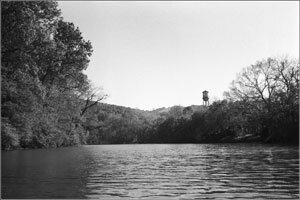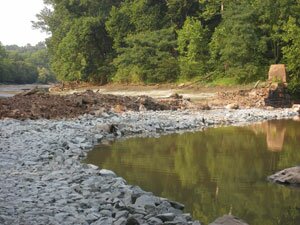NEWS- Mourned: Historic Woolen Mills dam remembered

Before the breach: The Woolen Mills dam in winter. Now only the left side of the dam remains.
PHOTO BY BILL EMORY
Even the most ardent supporters of taking down the Woolen Mills dam felt pangs of emotion as the breach, long in the works, finally started August 14. Within two days, the bulk of the historic dam was in rubble, and the rain-muddied Rivanna flowed free for the first time in nearly two centuries.
"I still have mixed emotions," says Presley Thach, whose family owns the site of the old Woolen Mills, now a storage yard, and the dam. "I thought the dam was pretty. Aesthetically, I enjoyed looking at it. But I still think environmentally it was the right thing to do."
The Rivanna Conservation Society, under point man Jason Halbert, led the charge to remove the dam so the American shad could return to its ancient spawning grounds. Others were not persuaded that opening the river for a few miles before the South Fork Rivanna Reservoir dam warranted taking down a historic structure, and a steady stream of visitors flowed down to the dam to pay their respects over the past few weeks.
This week, mitigation continues, and the fall will see trees planting and vegetation along the newly loosened banks of the Rivanna.
"It's a river again," says Thach. "It's going to be interesting to see where the channel is carved."

The dreaded horizon line, the last thing a daydreaming kayaker would see when the Woolen Mills dam was still intact.
PHOTO BY BILL EMORY

The Rivanna runs through it. Can the shad be far behind?
PHOTO BY ERIN HEISTERMAN
#
5 comments
I wanted to canoe that section with my son when he got older.
It was a beatiful pool all the way back to Free Bridge. Now it just another trickling creek.
A micro-hydro electric plant would have been cool.
Industrial history is history, too.
Who cares if the Shad can swim farther.
Is there a shad shortaqe or something?
what I find interesting is how nobody could say what the history is, not even a paragraph. Progress could only say 177-year-old dam so you had to do math to come up with 1830. Even this Hook article doesn't say when the dam was built or when the mill closed (1964). Next year we won't know when the dam was dismantled. How can a place be historic and nobody know any of the history? When we say "historic", we mean "it has history but I don't know any of it."
Reason would have us also consider the pre-dam "natural history" of the contiguous Rivanna River. The river's invaluable and pre-historical existence as a free-flowing, balanced system overwhelmingly exceeds the relatively minuscule anthropocentric history of this severely neglected and, until very recently, uncelebrated dam. True "history" includes, and transcends, humanity.
And, to answer your question, the state of Virginia and all co-signatories of the Chesapeake 2000 Agreement (VA, MD, PA, DC, & EPA) care "if the shad can swim farther". Maybe you should, too, since it is in fact your own tax dollars which finance federal and state agencies working to do exactly this.
"What a waste": I respectfully suggest that you perform a 'google' search re: your questions and assumptions from above (i.e. shad passage/fishery status, hydroelectric power generation and costs/river health/safety, C2K, fish passage, general environmental literacy for responsible parenting). You will be VERY surprised by what you will learn. Your questions and general reluctance appear to be largely based upon misperceptions and/or fear of change. Good news for you & your son: You will, for the first time, be able to safely canoe the entire mainstem Rivanna River without fear of injuring or killing self and son at the former dam site.
Cheer up -- Not everything is as bad as you had thought!
Would anyone have a video of the dam being removed? I bet that was quite the spectacle seeing all that water let go.
Also, any other information regarding to the dam would be helpful too. I am currently researching for a theoritical project that would take place in the memory of the dam and the mill.
You can email me at jdq5p at virginia . edu